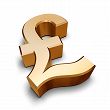GBP��������(0)�༭����
The pound sterling (symbol: £; ISO code: GBP), often simply called the pound,
is the currency of the United Kingdom, its Crown dependencies (the Isle of Man and the Channel Islands) and the British Overseas Territories of South Georgia and the South Sandwich Islands and British Antarctic Territory. It is subdivided into 100 pence (singular: penny).
The Gibraltar pound, Falkland Islands pound and Saint Helena pound are separate currencies, pegged to the pound sterling.
Sterling is the third-largest reserve currency, after the US dollar and the euro. The pound sterling is also the fourth-most-traded currency in the foreign exchange market after the US dollar, the euro, and the Japanese yen.
Currency of the United Kingdom
The pound scots had begun equal to sterling but had suffered far higher devaluation until being pegged to sterling at a value of 12 pounds scots = 1 pound sterling. In 1707, the Kingdom of England and the Kingdom of Scotland merged to form the United Kingdom of Great Britain. In accordance with the Treaty of Union, the currency of the 'united kingdom' was sterling with the pound scots being replaced by sterling at the pegged value.
Use in the Empire
Sterling circulated in much of the British Empire. In some parts, it was used alongside local currencies. For example, the gold sovereign was legal tender in Canada despite the use of the Canadian dollar. Several colonies and dominions adopted the pound as their own currency. These included Australia, Barbados, British West Africa, Cyprus, Fiji, Irish Free State, Jamaica, New Zealand, South Africa and Southern Rhodesia. Some of these retained parity with sterling throughout their existence (e.g. the South African pound), whilst others deviated from parity after the end of the gold standard (e.g. the Australian pound). These currencies and others tied to sterling constituted the Sterling Area.
Banknotes
The first sterling notes were issued by the Bank of England shortly after its foundation in 1694. Denominations were initially written on the notes at the time of issue. From 1745, the notes were printed in denominations between £20 and £1000, with any odd shillings added in hand. £10 notes were added in 1759, followed by £5 in 1793 and £1 and £2 in 1797. The lowest two denominations were withdrawn following the end of the Napoleonic wars. In 1855, the notes were converted to being entirely printed, with denominations of £5, £10, £20, £50, £100, £200, £300, £500 and £1000 issued.
On the value of British money
In 2006 the House of Commons Library published a document which included an index of the value of the pound for each year between 1750 and 2005, where the value in 1974 was indexed at 100. (This was an update of earlier documents published in 1998 and 2003.)
Regarding the period 1750�C1914 the document states: "Although there was considerable year on year fluctuation in price levels prior to 1914 (reflecting the quality of the harvest, wars, etc.) there was not the long-term steady increase in prices associated with the period since 1945". It goes on to say that "Since 1945 prices have risen in every year with an aggregate rise of over 27 times."
The value of the index in 1751 was 5.1, increasing to a peak of 16.3 in 1813 before declining very soon after the end of the Napoleonic Wars to around 10.0 and remaining in the range 8.5�C10.0 at the end of the nineteenth century. The index was 9.8 in 1914 and peaked at 25.3 in 1920, before declining to 15.8 in 1933 and 1934��prices were only about three times as high as they had been 180 years earlier.
Inflation had a dramatic effect during and after World War II��the index was 20.2 in 1940, 33.0 in 1950, 49.1 in 1960, 73.1 in 1970, 263.7 in 1980, 497.5 in 1990, 671.8 in 2000 and 757.3 in 2005.
Value against other currencies
The pound is freely bought and sold on the foreign exchange markets around the world, and its value relative to other currencies therefore fluctuates. It has been among the highest-valued base currency units in the world. As of 11 April 2009, £1 was worth US$1.466 or �1.113.
• Historical exchange rates (since 1990) are given in Exchange rates section of the Economy of the United Kingdom entry.
• Current wholesale exchange rates between sterling and other currencies can be viewed here.
The pound as a major international reserve currency
Sterling is used as a reserve currency around the world and is presently ranked third in amount held as reserves. The percentage which pounds make up of total reserves has increased over recent years, due in part to the stability of the British economy and government, gradual increase in value against many currencies and relatively high interest rates compared to other major currencies such as the dollar, euro and yen. As from mid 2006 it is the third most widely held reserve currency, having seen a resurgence in popularity in recent years. Analysts say this resurgence is caused by carry-trade investors considering the pound as a stable high-yield proxy to the euro.
Ӣ��(Great Britain Pound/Pound Sterling)��Ӣ�����һ��Һͻ��ҵ�λ���ơ�Ӣ����Ȼ��ŷ�˵ij�Ա��������δ����ŷԪ��������Ȼʹ��Ӣ����Ӣ����Ҫ��Ӣ�������з��У��������������л���������ڱ�ʾӢ���ķ����ǡꡣ���ʱ�����֯ΪӢ��ȡ��ISO 4217���Ҵ���ΪGBP (Great Britain Pound)��
����Ӣ����Ӣ��������صĻ���Ҳ����Ϊ��λ����Ӣ���Ļ��ʹ̶�Ϊ1:1
���ҵ�λ
����������ʷ���أ�Ӣ���Ļ��ҷ�����ͳһ���Ҽ�Ϊ���ӡ�
������Ӣ����������˹��Ӣ��������ȯΪ������֮�������ң�����ϿȺ���������ȸ��ط�������ӡ����Ӣ��������ȯ��ֵֽ֮�ң���Ϊ����֮�������ҡ�Ȼ�����ո����ͱ������������в���������֮˵��������и�����ֽ��ʵΪӢ�����ҵĶһ�ȯ��
������ʹ�ڳ��Ϸ��ҵ�Ӣ��������ν���������ҡ���ָ��ծ������Ժ�����õȻ������ʱ��ծȨ�˲�������ծ����Ƿծ�������ճ�����֮���������ƣ���Ϊ��Ϊ���Ǻ�Լ���ɡ�
��ʱ��Ӣ��
��ʱ��Ӣ��Ҳ�С�Ӣ������һӢ������100�±�ʿ(New Pence)��Ӳ�ҷ�Ϊ���ʿ(halfpenny���1985��ֹͣ��ͨ)��1��ʿ��2��ʿ��5��ʿ��10��ʿ,20��ʿ,һ����(25��ʿ���1990��ֹͣ��ͨ),50��ʿ,1����2����5��(1990���п���)������Ӳ�������ΪӢ��������������б�ֵ�⣬�ڲ�ͬ������������Ӳ�����в�ͬ��ͼ����������Ӳ����Ǹ����������죬��ȫ��ͨ�á�Ӣ��ֽ�ҷ�Ϊ1��(�1988��ֹͣ��ͨ)��5����10����20����50�������б�ֵ��ֽ�������ӡ��Ӣ��������,��ż���ֵ����ͬ��ֵ��ֽ�ң�������ӡ�в�ͬ��Ӣ��������
�����
Ӣ������
• Ӣ��������(Bank of England)
�ո�����
• �ո�������(Bank of Scotland)
• �ո����ʼ�����(The Royal Bank of Scotland)
• �����ȴ������У�Clydesdale Bank��
����������
• ����������(Bank of Ireland)
• ��һ��������(First Trust Bank)
• ��������(Northern Bank)
• ����˹������(Ulster Bank)
���������� ���������� ��������
��ʷ
��Ӣ��(LSD���sd)
����1971��δ���б�ֵʮ����֮ǰ��һӢ������20�����1�����ֵ���12��ʿ������֮��һӢ������240��ʿ�� ��ʱ��Ӳ�ҷ�Ϊ:
• Farthing (һ��ʿ���ķ�֮һ�����e�ı�ʿ��ָ�ɱ�ʿ����ͬ�����һ��������1956�꣬1960��ĩֹͣ��ͨ)
• Half Penny (���ʿ��һ��ʿ�Ķ���֮һ�����һ��������1967�꣬1969��8��1��ֹͣ��ͨ)
• One Penny (һ��ʿ�����һ��������1967�꣬1971��8��31��ֹͣ��ͨ)
• Three Pence (3��ʿ�����ķ�֮һ������һ��������1967�꣬1971��8��31��ֹͣ��ͨ)
• Six Pence (6��ʿ������������һ��������1967�꣬1980��6��ֹͣ��ͨ)
• One Shilling (һ������һ��������1967�꣬1971����б�ֵʮ���ƺ�ɵ�5��ʿʹ�ã�1990��ĩ��ɰ汾����5��ʿӲ��ֹͣ��ͨ)
• Two Shillings (�ֽ� Florin��2������һ��������1967�꣬1971����б�ֵʮ���ƺ�ɵ�10���±�ʿʹ�ã�1993��7��1����ɰ汾����10��ʿӲ��ֹͣ��ͨ)
• Half Crown (����ɣ���2����6��ʿ�����һ��������1967�꣬1970��ֹͣ��ͨ)
• Crown (һ���ɣ���5������һ��������1965�꣬1970��ֹͣ��ͨ)
�롰pound,Ӣ��,���ҡ���صĴ���
→�������Ϊ���������д����ƣ��� �༭����
�������ݽ����ο����������Ҫ�����������
�������ڷ��ɡ�ҽѧ��������������ѯ�������רҵ��ʿ��
0

ͬ���: ����ͬ���
���ڱ����������� (��0������������>>










